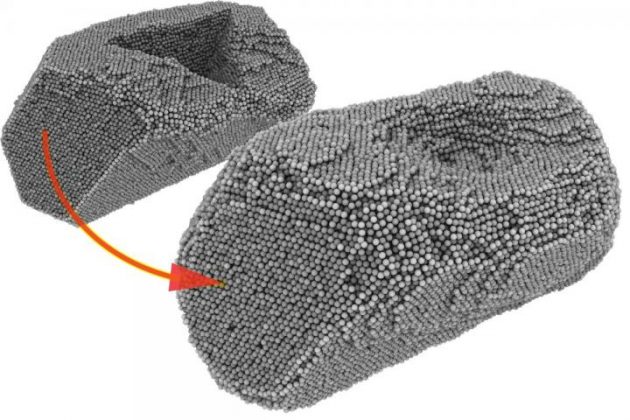
Scientists discover self-healing powers of pure gold
By Design Engineering staff
MaterialsBelow melting temperature annealing property could lead to robust MEMS.
Gold has always held a fascination for people. It has been sought after by miners, treasure hunters and the like. Now, scientists, too are enamoured by the self-healing capabilities of pure gold.

Gold atoms have moved into the dent produced before, refilling it almost completely.Photo credit: KIT.
Researchers at the Karlsruhe Institute of Technology (KIT) and the Technion – Israel Institute of Technology have discovered that also tiny particles of pure gold have surprising self-healing capacities.
So far, it has been considered impossible for pure metals to use self-healing capacities to repair mechanically caused defects. However, scientists have observed this phenomenon in pure gold particles.
“The search for materials of this kind so far has been concentrated on polymers made up of many components and complicated structures,” states Christian Brandl of the Institute for Applied Materials – Materials and Biomechanics (IAM-WBM).
The self-healing abilities were all based on the collective transformation of the phases of one or more materials making them up. In metal alloys, the shape memory effect is based on the phenomenon that they can exist in two different crystal structures as a function of a specific temperature. When this is changed, the metals “remember” their former shape they had at that respective temperature. However, this self-healing effect is never complete in composites or in alloys.
Self-healing or shape memory in pure metals has never fully been understood.
The team observed multi-shaped particles as they resumed their individual original shapes almost completely. There was no deformation of any kind.
“The fascinating thing about this is that the restored particle shapes did not correspond to that with the lowest surface energy, as would have been expected,” says Brandl.
The scientists had produced mechanical defects in the particles first in simulations by high-power computers and then, in reality, with the measurement tip of a scanning force microscope.
They found that annealing air temperatures far below the melting temperature of gold caused gold atoms to move along surface steps back into the dents, refilling them almost completely. Such surface steps occur in many deformed metals.
Brandl explains that these findings could have far reaching applications beyond pure gold. The scientists anticipate that their findings will allow robust components for structures smaller than one thousandth of a millimeter to be designed.
The research is reported in the Advanced Science journal.
